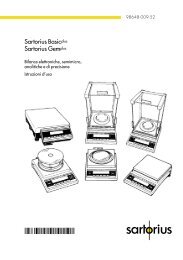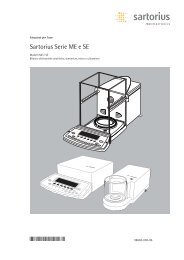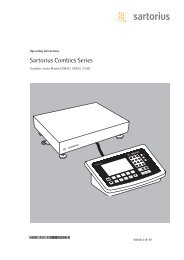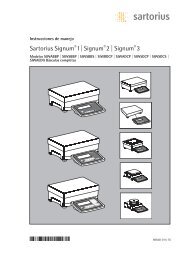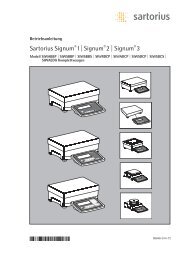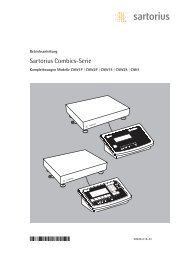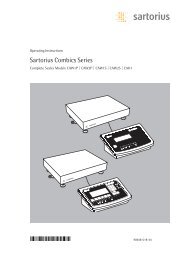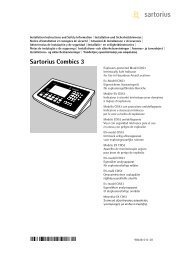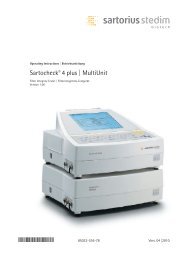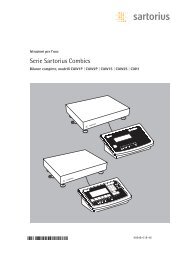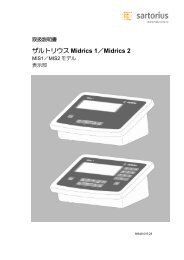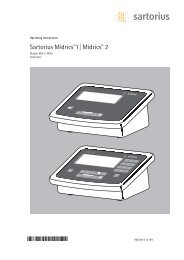DNA Binding on Sartobind STIC® compared to ... - Sartorius AG
DNA Binding on Sartobind STIC® compared to ... - Sartorius AG
DNA Binding on Sartobind STIC® compared to ... - Sartorius AG
You also want an ePaper? Increase the reach of your titles
YUMPU automatically turns print PDFs into web optimized ePapers that Google loves.
Applicati<strong>on</strong> Note<br />
<str<strong>on</strong>g>DNA</str<strong>on</strong>g> <str<strong>on</strong>g>Binding</str<strong>on</strong>g> <strong>on</strong> <strong>Sar<strong>to</strong>bind</strong> STIC ® <strong>compared</strong> <strong>to</strong> <strong>Sar<strong>to</strong>bind</strong> ® Q<br />
Salt Tolerant Membrane Chroma<strong>to</strong>graphy<br />
Introducti<strong>on</strong><br />
One of the key applicati<strong>on</strong>s for membrane<br />
chroma<strong>to</strong>graphy is c<strong>on</strong>taminant removal in<br />
flowthrough mode. Ani<strong>on</strong> exchange by<br />
<strong>Sar<strong>to</strong>bind</strong> Q membranes is proven <strong>to</strong> remove<br />
<str<strong>on</strong>g>DNA</str<strong>on</strong>g> below the detecti<strong>on</strong> limit at process<br />
c<strong>on</strong>diti<strong>on</strong>s 1. The present study shows that<br />
<strong>Sar<strong>to</strong>bind</strong> STIC PA with its primary amine<br />
ligand is much less susceptible <strong>to</strong> decreasing<br />
capacities at high salt c<strong>on</strong>diti<strong>on</strong>s than the Q<br />
(quaternary amm<strong>on</strong>ium) matrix. The measurements<br />
have been performed in 96 well plates<br />
by vacuum manifold or at a liquid chroma<strong>to</strong>graphy<br />
system in a membrane holder.<br />
1. Screening of salt and pH c<strong>on</strong>diti<strong>on</strong>s for<br />
<str<strong>on</strong>g>DNA</str<strong>on</strong>g> binding with 96 well plates (high <str<strong>on</strong>g>DNA</str<strong>on</strong>g><br />
c<strong>on</strong>centrati<strong>on</strong>)<br />
The influences of salt and pH c<strong>on</strong>diti<strong>on</strong>s for<br />
<str<strong>on</strong>g>DNA</str<strong>on</strong>g> removal was evaluated using <strong>Sar<strong>to</strong>bind</strong><br />
STIC PA and Q membranes. Due <strong>to</strong> the 96 well<br />
plate format, the sample volume and analysis<br />
time could be reduced c<strong>on</strong>siderably.<br />
1.2 Materials and methods<br />
Device format 96 well plate<br />
Membrane Types <strong>Sar<strong>to</strong>bind</strong> STIC PA and Q<br />
Membrane area 1 cm²/well<br />
Membrane<br />
volume<br />
0.028 ml<br />
Membrane layers 3<br />
C<strong>on</strong>diti<strong>on</strong>ing 0.5 ml/well 1 M NaCl<br />
Equilibrati<strong>on</strong><br />
buffer<br />
Equilibrati<strong>on</strong><br />
volume<br />
Bis Tris 20 mM, pH 6 and 7<br />
Tris 20 mM, pH 8 and 9<br />
1 ml/well<br />
<str<strong>on</strong>g>Binding</str<strong>on</strong>g> buffer Each equilibrati<strong>on</strong> buffer<br />
with 0, 300, 500 and<br />
650 mM NaCl (approx. 0.8,<br />
6.5, 20 and 36 mS/cm<br />
respectively)<br />
<str<strong>on</strong>g>DNA</str<strong>on</strong>g> sample Salm<strong>on</strong> sperm <str<strong>on</strong>g>DNA</str<strong>on</strong>g><br />
(500 - 1000 bp)<br />
<str<strong>on</strong>g>DNA</str<strong>on</strong>g><br />
c<strong>on</strong>centrati<strong>on</strong> (c)<br />
<str<strong>on</strong>g>DNA</str<strong>on</strong>g> loading<br />
volume (V)<br />
~145 μg/ml<br />
1.0 ml per well<br />
Plate reader Tecan Safire<br />
(Tecan Group Ltd.<br />
Männersdorf, Switzerland)<br />
Robot liquid<br />
handling system<br />
Lissy 2002 (Zinsser,<br />
Frankfurt, Germany)<br />
In <strong>to</strong>tal, 32 c<strong>on</strong>diti<strong>on</strong>s (4 different salt c<strong>on</strong>centrati<strong>on</strong><br />
at 4 different pH for two types<br />
of membranes) with each 4 parallel samples<br />
were tested using au<strong>to</strong>matic robot system.<br />
The amount of <str<strong>on</strong>g>DNA</str<strong>on</strong>g> loaded was chosen so<br />
that a breakthrough could be observed.<br />
Salm<strong>on</strong> sperm <str<strong>on</strong>g>DNA</str<strong>on</strong>g> c<strong>on</strong>centrati<strong>on</strong> in the<br />
flowthrough fracti<strong>on</strong> was determined at<br />
260 nm by au<strong>to</strong>matic sampling.
1.3 Results<br />
Figure 1 shows the influence of sodium chloride<br />
c<strong>on</strong>centrati<strong>on</strong> and pH c<strong>on</strong>diti<strong>on</strong>s for <str<strong>on</strong>g>DNA</str<strong>on</strong>g><br />
binding <strong>to</strong> ani<strong>on</strong> exchanger membranes.<br />
<strong>Sar<strong>to</strong>bind</strong> STIC PA bound stable salm<strong>on</strong> sperm<br />
<str<strong>on</strong>g>DNA</str<strong>on</strong>g> at pH 6–9 in the entire NaCl c<strong>on</strong>centrati<strong>on</strong><br />
range (0 <strong>to</strong> 650 mM). <strong>Sar<strong>to</strong>bind</strong> Q shows<br />
breakthrough at 300 mM NaCl.<br />
Small working volumes, an au<strong>to</strong>matic liquid<br />
handling system and high flow rates allowed<br />
the testing of up <strong>to</strong> 96 c<strong>on</strong>diti<strong>on</strong>s in less than<br />
1 hour.<br />
c/c0<br />
c/c0<br />
1.00<br />
0.90<br />
0.80<br />
0.70<br />
0.60<br />
0.50<br />
0.40<br />
0.30<br />
0.20<br />
0.10<br />
0.00<br />
1.00<br />
0.90<br />
0.80<br />
0.70<br />
0.60<br />
0.50<br />
0.40<br />
0.30<br />
0.20<br />
0.10<br />
0.00<br />
<strong>Sar<strong>to</strong>bind</strong> STIC PA at pH 6 - 9<br />
0.00 100.00 200.00 300.00<br />
NaCl [mM]<br />
400.00 500.00 600.00<br />
<strong>Sar<strong>to</strong>bind</strong> Q at pH 6 - 9<br />
0.00 100.00 200.00 300.00<br />
NaCl [mM]<br />
400.00 500.00 600.00<br />
Fig. 1: Breakthrough performance of <str<strong>on</strong>g>DNA</str<strong>on</strong>g> of <strong>Sar<strong>to</strong>bind</strong> STIC and Q at different salt and<br />
pH c<strong>on</strong>diti<strong>on</strong>s (high <str<strong>on</strong>g>DNA</str<strong>on</strong>g> c<strong>on</strong>centrati<strong>on</strong>)<br />
6<br />
7<br />
8<br />
9<br />
6<br />
7<br />
8<br />
9
2. Screening of salt and pH c<strong>on</strong>diti<strong>on</strong>s<br />
for <str<strong>on</strong>g>DNA</str<strong>on</strong>g> binding with 96 well plates<br />
(low <str<strong>on</strong>g>DNA</str<strong>on</strong>g> c<strong>on</strong>centrati<strong>on</strong>)<br />
In this experiment, large <str<strong>on</strong>g>DNA</str<strong>on</strong>g> fragments in<br />
low c<strong>on</strong>centrati<strong>on</strong> were used at different pH<br />
and NaCl c<strong>on</strong>centrati<strong>on</strong>s in comparis<strong>on</strong> <strong>to</strong><br />
the first experiment.<br />
2.2 Materials and methods<br />
Equilibrati<strong>on</strong><br />
buffer<br />
20 mM NaAc pH 4.5 and 5.5<br />
20 mM Bis Tris 6.5;<br />
20 mM Tris 7.5 and 8.5<br />
20 mM CHES pH 9.5<br />
<str<strong>on</strong>g>Binding</str<strong>on</strong>g> buffer Each equilibrati<strong>on</strong> buffer<br />
with 0, 300, 500 and<br />
1000 mM (approx. 1.1, 26,<br />
41 and 75 mS/cm)<br />
<str<strong>on</strong>g>DNA</str<strong>on</strong>g> sample Calf thymus <str<strong>on</strong>g>DNA</str<strong>on</strong>g><br />
(up <strong>to</strong> 24000 bp)<br />
<str<strong>on</strong>g>DNA</str<strong>on</strong>g><br />
~100 ng/ml<br />
c<strong>on</strong>centrati<strong>on</strong> (c)<br />
Refer <strong>to</strong> 1.2 for other materials.<br />
Because of a very low <str<strong>on</strong>g>DNA</str<strong>on</strong>g> c<strong>on</strong>centrati<strong>on</strong>,<br />
PicoGreen standard assay (PicoGreen ds<str<strong>on</strong>g>DNA</str<strong>on</strong>g><br />
Quant-iT P7581 Reagent, Life Technologies,<br />
Carlsbad, USA) was used for <str<strong>on</strong>g>DNA</str<strong>on</strong>g> analysis.<br />
The sampling was performed manually and<br />
for the assay, 96 well micro plates (Greiner<br />
Bio-One Internati<strong>on</strong>al <strong>AG</strong>, Austria) were used.<br />
Breakthrough was calculated by comparing<br />
the PicoGreen signal of each s<strong>to</strong>ck soluti<strong>on</strong><br />
and flowthrough. Detecti<strong>on</strong> limit of the<br />
PicoGreen Assay was ~1 ng/ml.<br />
2.3 Results<br />
As in the first trial with smaller <str<strong>on</strong>g>DNA</str<strong>on</strong>g> in higher<br />
c<strong>on</strong>centrati<strong>on</strong>, no breakthrough was found<br />
<strong>on</strong> <strong>Sar<strong>to</strong>bind</strong> STIC PA in the whole range<br />
of pH (4.5–9.5) and NaCl c<strong>on</strong>centrati<strong>on</strong><br />
(0–1000 mM). On <strong>Sar<strong>to</strong>bind</strong> Q, breakthrough<br />
was seen at 500 mM NaCl <strong>compared</strong> <strong>to</strong> the<br />
first trial.<br />
c/c0<br />
c/c0<br />
1.00<br />
0.90<br />
0.80<br />
0.70<br />
0.60<br />
0.50<br />
0.40<br />
0.30<br />
0.20<br />
0.10<br />
0.00<br />
1.00<br />
0.90<br />
0.80<br />
0.70<br />
0.60<br />
0.50<br />
0.40<br />
0.30<br />
0.20<br />
0.10<br />
0.00<br />
4.5<br />
5.5<br />
6.5<br />
7.5<br />
8.5<br />
9.5<br />
Breakthrough of <str<strong>on</strong>g>DNA</str<strong>on</strong>g> <strong>Sar<strong>to</strong>bind</strong> STIC PA<br />
0 200 400<br />
NaCl [mM]<br />
600 800 1000<br />
4.5<br />
5.5<br />
6.5<br />
7.5<br />
8.5<br />
9.5<br />
Breakthrough of <str<strong>on</strong>g>DNA</str<strong>on</strong>g> <strong>Sar<strong>to</strong>bind</strong> Q<br />
0 200 400<br />
NaCl [mM]<br />
600 800 1000<br />
Fig. 2: Breakthrough performance of <str<strong>on</strong>g>DNA</str<strong>on</strong>g> of <strong>Sar<strong>to</strong>bind</strong> STIC and Q at different salt and<br />
pH c<strong>on</strong>diti<strong>on</strong>s (low <str<strong>on</strong>g>DNA</str<strong>on</strong>g> c<strong>on</strong>centrati<strong>on</strong>)
3. <str<strong>on</strong>g>DNA</str<strong>on</strong>g> binding capacity measurement at<br />
LC system<br />
The <str<strong>on</strong>g>DNA</str<strong>on</strong>g> binding capacity at 10% breakthrough<br />
for both <strong>Sar<strong>to</strong>bind</strong> STIC PA and Q<br />
membranes were measured using a LC system.<br />
3.1 Materials and methods<br />
Device format Membrane discs in a holder<br />
Membrane area 15 cm² (5 cm² each layer)<br />
Membrane layers 3<br />
<str<strong>on</strong>g>Binding</str<strong>on</strong>g> buffer 20 mM Tris/HCl pH 7.2,<br />
150 mM NaCl<br />
<str<strong>on</strong>g>DNA</str<strong>on</strong>g> sample Salm<strong>on</strong> sperm <str<strong>on</strong>g>DNA</str<strong>on</strong>g><br />
(500 - 1000 bp)<br />
LC system Akta explorer<br />
(GE Healthcare)<br />
The flow rate was 10 ml/min. After equilibrati<strong>on</strong><br />
with 10 ml buffer, salm<strong>on</strong> sperm <str<strong>on</strong>g>DNA</str<strong>on</strong>g><br />
binding capacity at 10% breakthrough was<br />
determined at 260 nm (see 1.3).<br />
3.3 Result<br />
The binding capacity for <strong>Sar<strong>to</strong>bind</strong> STIC PA<br />
was 10.9 and for Q 7.3 mg/ml in presence of<br />
150 mM NaCl.<br />
4. Summary<br />
<strong>Sar<strong>to</strong>bind</strong> 96 well plate membrane devices are<br />
effective <strong>to</strong>ols for rapid process development.<br />
<str<strong>on</strong>g>DNA</str<strong>on</strong>g> removal using <strong>Sar<strong>to</strong>bind</strong> STIC PA membrane<br />
is almost independent of NaCl c<strong>on</strong>centrati<strong>on</strong><br />
up <strong>to</strong> 1 M NaCl.<br />
Reference<br />
1. Joachim K. Walter, Boehringer Ingelheim<br />
Pharma KG, Strategies and C<strong>on</strong>siderati<strong>on</strong>s<br />
for Advanced Ec<strong>on</strong>omy in Downstream<br />
Processing of Biopharmaceutical Proteins.<br />
In: Bioseparati<strong>on</strong> and Bioprocessing;<br />
G. Subramanian, (Ed.), Processing, Quality<br />
and Characterizati<strong>on</strong>, Ec<strong>on</strong>omics, Safety<br />
and Hygiene, Wiley VCH, 1998, vol. II,<br />
pp.447-460<br />
Sar<strong>to</strong>rius Stedim Biotech GmbH<br />
August-Spindler-Strasse 11<br />
37079 Goettingen, Germany<br />
Ph<strong>on</strong>e +49.551.308.0<br />
Fax +49.551.308.3289<br />
www.sar<strong>to</strong>rius-stedim.com<br />
USA Toll-Free +1.800.368.7178<br />
UK +44.1372.737159<br />
France +33.442.845600<br />
Italy +39.055.63.40.41<br />
Spain +34.90.2110935<br />
Japan +81.3.3740.5407<br />
<strong>Sar<strong>to</strong>bind</strong> ®, and <strong>Sar<strong>to</strong>bind</strong> STIC ® are trademarks<br />
of Sar<strong>to</strong>rius Stedim Biotech GmbH<br />
Technical data are subject <strong>to</strong> change<br />
without notice.<br />
Printed in Germany <strong>on</strong> paper that has<br />
been bleached without any use of chlorine.<br />
First published:<br />
November 30, 2010<br />
Publicati<strong>on</strong> No.: SL-4058-e10121<br />
Order No.: 85032-538-43<br />
Ver. 12 | 2010



